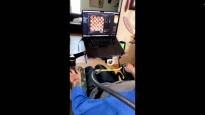Noland Arbaugh can move a cursor through a Neuralink implant.
Paralyzed from the neck down Noland Arbaugh has played chess with the help of a chip implanted in his brain in a live broadcast on the messaging service X.
Paralyzed in a diving accident eight years ago, Arbaugh is able to move the computer cursor while playing chess with the help of a chip installed in his brain.
Siru is a billionaire Elon Musk’s developed by the neurotechnology company Neuralink. Arbaugh is the first person to have that chip implanted.
In the video, Arbaugh describes the operation of the chip like this:
– We tried separately imagining the movement and trying to move it. For example, I tried to move my right hand right, left and forward. I instinctively began to imagine moving the cursor. I focused as if to force the cursor to move. I made it move on the screen where I wanted. I looked at a certain point on the screen and the cursor moved to the point I wanted. It was a wild experience.
– I like playing chess. It was one of the first things I did with Neuralink. Since my injury, I have hardly been able to play chess. I’ve been using a controller controlled by my mouth, but now I can move the cursor with my brain.
Neuralink’s goal is to build communication links between the human brain and computers to make life easier for people with paralysis and neurological problems.
The goal is also that chips could be used to promote the treatment of neurological diseases such as ALS or Parkinson’s disease in the future.
Arbaugh, 29, had a brain chip implanted in January. The chip implanted in the skull is described as the size of a coin.
– The surgery was very easy. I got out of the hospital the next day, he says.
Neuralink is not the only company working in the development of so-called brain interfaces.
The emeritus professor of technical physics interviewed by in January Risto Ilmoniemi said that Neuralink’s chip is not a significant scientific advance.
Ilmoniemi stated that people with Parkinson’s disease have been fitted with electric stimulators. In addition, devices have already been developed that allow paralyzed people to move their muscles or devices with signals sent from the brain.
